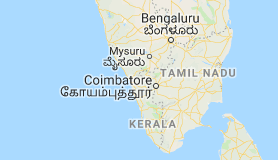
According to an India government intelligence report, “in a few years Naxalism will have a consolidated front in Western Ghats and tri-junction area.”
New Delhi: Naxals are on the verge of creating a ‘consolidated front’ on the Western Ghats.
The tri-junction being the dense forests of the region where the states of Karnataka, Tamil Nadu and Kerala meet.
Naxals are expanding at an alarming rate in this region because of three main reasons.
— First is the nature of area that Naxals are exploiting—places which have least government penetration and consequently maximum dissatisfaction against the state.
The Naxal division working specifically on this region, being squeezed by forces on all sides in Bastar area, is Western Ghats Special Zonal Committee (WGSZC).
Over the past few weeks, the report states, “most number of Naxal sightings were from Wayannad, Mallapuram, Kannur, Kozhikode and Palakkad districts of Kerala and in terms of human development indicators these districts lie at the bottom, thus, constituting perspective area for naxal growth and operation.”
— The other problem is that Naxals have set their bases up in, as the report states, the “unexplored jungles” in the tri-junction region. This is the area that was under firm control of the brigand Veerappan.
So while “Tamil Nadu police and Karnataka police had a firsthand experience of the jungle in their respective states due to the forest brigand Veerappan,” Kerala still has very little knowledge about the topography, which has resulted in a rapid expansion by Naxals in this area.
According to intelligence shared by police departments of Tamil Nadu and Karnataka with central agencies, Naxals are also getting familiarised and trained according to the terrain. Arms training is regularly being undertaken in dense jungles of Wayanad.
Due to the frequent operations by Anti-naxal Force and the special task forces of Karnataka and Tamil Nadu Naxals were forced to flee towards the jungle areas of Kerala, the intel report adds.
“But for Kerala, combing operation is new to them and requires assistance. Kerala has vast jungle areas that are left unexplored.”
— There is yet another hurdle for the forces to deal with in order to counter the growing influence of Naxals in the tri-junction area—since in the dense forests there is no way to mark boundaries, problems of jurisdiction arise. These problems can only be dealt with a coordinating agency for conducting anti-Naxal operations for all the three states. Such an authority does not exist so far.
All these issues have come together to fuel activities of Naxal fronts that have “increased considerably” in places like Erode, which lies in Tamil Nadu, but is close to both Karnataka and Kerala.
Senior officers say that the Kerala has been identified to be “vulnerable” due to less manpower and inadequate weaponry. This has caused the three states to demand deployment of central troops just as is the case in the Dandakaranya zone which includes parts of Chhattisgarh, Odisha, Telangana and Andhra Pradesh.


No comments:
Post a Comment